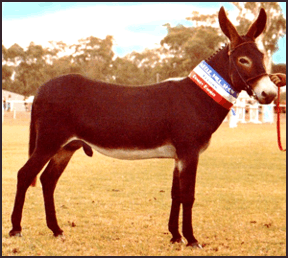
COMMON HORSE BREEDS
| DONKEY
Origin: |
 Photo supplied by the Donkey Society of NSW Inc. © |
History:
It is believed that the donkey originated from subspecies of the African
wild ass in Nubia but little is known about its domestication. The earliest findings were
made in Lower Egypt at a site at Ma'adi.
Donkeys were popular pack animals as they could be easily led by any type of halter and
could be trained to follow a route on their own. They increased the mobility of the local
people as riding animals providing the opportunity to search for new pastures. Donkeys
proved vital in developing the long-distance trade through the Egyptian deserts. In
ancient Egypt large herds were held providing a source of meat and mares were kept as
dairy animals with the milk used for drinking, as medicine and as a cosmetic. The animals
proved also useful for farm work, treading seeds into the fertile Nile floodplain and
threshing the harvest.
Eventually donkeys spread to almost every part of the world. By the end of the fourth
millennium BC they had reached south west Asia, by the second millennium BC Europe, by
1800 BC the centre of ass-breeding had shifted to Mesopotamia, and in 1495 donkeys arrived
in South America on a supply ship for Christopher Columbus.
In the 19th century donkeys played an important part in North American desert mining
operations carrying water, wood and machinery to the mines, hauling cartloads of rock and
ore out of mine tunnels and carrying the ore to the mills. They also turned the mills to
grind the ore. At the end of the mining boom most donkeys were set loose and many still
live freely in the American desert.
More recently a new interest in the donkey developed using its guarding instinct as it can
protect an entire herd of cattle or sheep from predators. Donkeys also gain interest in
recreational activities and appear on stock shows where their stiff manes are often
clipped short or shaved close to the neck.
Characteristics:
differ in conformation to horses
Head: long ears
Neck: straight
Body: straight back due to lack of true withers; often dipped
or swayed backs
Legs: good bone; upright pasterns
Feet: small, round hooves
Mane: stiff, upright, rarely laying over; no true forelock
Tail: coarse; covered with short body hair, ending in
tasselled switch
Color: predominantly grey-dun; all shades of grey-dun to
brown; spotted patterns, dorsal stripes, shoulder crosses, dark ear marks, white muzzle
and eye rings, white belly and inner leg; occasionally zebra stripes
Height: miniature to 14 hands and up
Voice: raspy, brassy bray; Aw-EE, Aw-EE sound; enjoy using
voice at any opportunity
Temperament: lazy, self-preserving, stubborn, friendly
Qualities: great guarding instinct, good with children,
trainable
TERMS:
Ass: correct term for a donkey
Jack: male ass
Jennet: female ass, often called Jenny
Get: offspring of a jack
Produce: offspring of a jennet
Jennet Jack: jackass used to breed to jennets to produce
donkeys
Mule Jack: jackass used to breed to horse mares to produce
mules
Jack Stock: American Mammoth jack and jennet, one of the
largest types of asses
Burro: Spanish word, describing a working donkey in Spain and
Mexico
Today:
Donkeys are becoming popular as recreation and companion animals. They are
suitable for riding and harness work and occasionally replace horses as pack and riding
animals on wilderness tours. On farms they are used to halterbreak calves and to guard the
herds of stock, protecting them from predators.
![]()